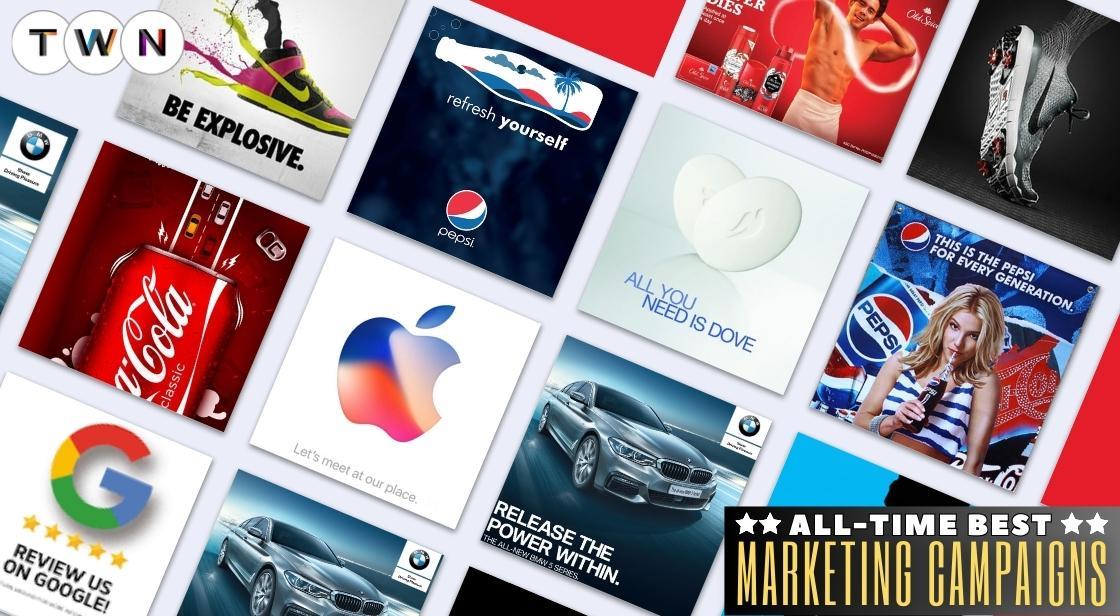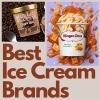All Times Best Marketing Campaigns

Blog Post
Marketing campaigns have the power to transcend their original intent, becoming iconic and timeless in the process. These all-time best marketing campaigns not only achieved their goals but also shaped the advertising landscape, leaving a lasting impact on audiences and society at large.
In this article, we'll explore some of these legendary campaigns, uncovering the strategies and creativity that propelled them to greatness.
From Coca-Cola's "Share a Coke" campaign that personalized the beverage giant's products to Dove's "Real Beauty Sketches" campaign, which challenged societal beauty standards, these stories showcase the art and science of marketing.
We'll also delve into the humor and product comparison used by Apple's "Get a Mac" campaign and the viral marketing genius of Old Spice's "The Man Your Man Could Smell Like."
Join us on a journey through the world of marketing brilliance, where creativity meets strategy, and campaigns become cultural touchstones.
Marketing campaigns have the power to influence, inspire, and captivate audiences worldwide. Over the years, several marketing campaigns have not only achieved their intended goals but have also become legendary in the world of advertising.
These campaigns have left an enduring mark, showcasing the creativity, innovation, and effectiveness of marketing strategies.
In our previous article titled "Unveiling the Significance of Marketing Campaigns in Business," we delved into the fundamental elements that make up a successful marketing campaign. We also explored how contemporary trends and valuable insights influence the way these campaigns are carried out.
Furthermore, we emphasized the pivotal role of tailor-made campaigns in establishing connections with specific target demographics and driving enduring triumph in the business realm.
In this article, we'll delve into some of the all-time top marketing campaign success stories, highlighting their impact and the strategies that led to their unparalleled success.
All times Best Marketing Campaigns
1. Nike's "Just Do It"
Highlight: Inspiring messaging and celebrity endorsements
In the annals of marketing history, few campaigns have left as profound an impact as Nike's "Just Do It." Launched in 1988, this campaign has not merely endured the test of time but has become an intrinsic part of our cultural lexicon.
Let's delve deeper into the inspiring messaging, celebrity endorsements, and enduring legacy of this iconic campaign.
The Birth of a Slogan
The heart of the "Just Do It" campaign lies in its three simple words. These words encapsulate the essence of motivation, determination, and the relentless pursuit of one's goals. Nike, known for its innovative athletic footwear and apparel, sought to rebrand itself as more than just a product; it aimed to become a symbol of empowerment and achievement.
The Power of Inspiration
At its core, "Just Do It" is a call to action. It urges individuals to overcome obstacles, break through self-imposed limitations, and take that bold step towards their aspirations.
The slogan resonates across age, gender, and cultural boundaries, serving as a universal message of empowerment. It speaks to the dreamers, the athletes, the everyday heroes, and anyone seeking to push their limits.
Celebrity Endorsements
One of the campaign's masterstrokes was its strategic use of celebrity endorsements. Nike featured some of the world's most celebrated athletes, including basketball legend Michael Jordan and tennis sensation Serena Williams.
By associating itself with these sports icons, Nike not only elevated its brand image but also conveyed a powerful message – that greatness and success were within reach for those who dared to dream and work relentlessly.
Michael Jordan: Airborne Excellence
Michael Jordan, often regarded as one of the greatest basketball players in history, became the face of "Just Do It." His partnership with Nike birthed the iconic Air Jordan sneakers.
The image of Jordan soaring through the air, defying gravity, and making seemingly impossible dunks, became symbolic of what "Just Do It" stood for – the ability to transcend boundaries and achieve the extraordinary.
Serena Williams: Unstoppable Determination
The inclusion of Serena Williams, a tennis legend with an unwavering commitment to her craft, further solidified Nike's message. Williams, with her powerful presence on and off the tennis court, embodied the spirit of determination and resilience. Her association with "Just Do It" reinforced the idea that success required relentless effort and unwavering self-belief.
Enduring Legacy
Decades after its launch, "Just Do It" remains one of the most recognizable and enduring brand taglines in the world. It has transcended its initial purpose as a marketing slogan to become a philosophy for life.
Whether you're an athlete striving for excellence or an individual facing personal challenges, "Just Do It" serves as a reminder that the power to overcome, achieve, and excel resides within each one of us.
2. Coca-Cola's "Share a Coke"
Highlight: Personalization and consumer engagement
Coca-Cola's "Share a Coke" campaign was a brilliant example of how personalization and consumer engagement can be used to create a successful marketing campaign.
The campaign was launched in 2011 in Australia and New Zealand, and it was so successful that it was rolled out to other countries around the world.
The campaign involved replacing the Coca-Cola logo on bottles and cans with popular first names and endearing terms. This allowed consumers to find and share a Coke with friends and loved ones, making the brand more relatable and personal.
The campaign was also supported by a strong social media presence, where people could share photos and videos of themselves with their personalized Cokes.
The "Share a Coke" campaign was a huge success. It led to a 2.5% increase in U.S. sales and generated a significant buzz on social media. The campaign was also praised by marketing experts for its innovative approach to personalization and consumer engagement.
Below are several crucial elements that played a significant role in the triumph of the "Share a Coke" campaign:
-
Personalization: The use of popular first names and endearing terms made the campaign more personal and relatable to consumers. People were more likely to connect with a brand that felt like it was speaking directly to them.
-
Consumer engagement: The campaign encouraged consumers to share their personalized Cokes on social media, which helped to generate a lot of buzz and excitement around the campaign. People were excited to find their name on a Coke bottle and to share it with their friends.
-
Strong execution: The campaign was well-executed and well-targeted. The right message was delivered to the right audience at the right time.
The "Share a Coke" campaign is a great example of how personalization and consumer engagement can be used to create a successful marketing campaign. It is a campaign that is still talked about today, and it is a campaign that continues to inspire marketers.
Consider the following aspects when developing a prosperous marketing campaign:
-
Understand your target audience: It is important to understand who your target audience is and what they care about. This will assist in shaping a message that resonates with your intended audience.
-
Be creative and innovative: Don't be afraid to think outside the box and try new things. The most successful marketing campaigns are often the ones that are the most creative and innovative.
-
Measure your results: It is important to track the results of your marketing campaigns so that you can see what is working and what is not. This will help you to improve your campaigns over time.
3. Apple's "Get a Mac"
Highlight: Effective use of humor and product comparison
Apple's "Get a Mac" campaign was a brilliant example of how humor and product comparison can be used to create a successful marketing campaign. The campaign was launched in 2006 and ran for three years.
It featured two actors, John Hodgman as a PC and Justin Long as a Mac, who would engage in witty dialogue about the respective merits of their computers.
The campaign was a huge success. It helped to solidify Apple's image as a innovative and user-friendly brand, and it contributed to the company's rise in market share. The campaign was also praised by marketing experts for its effective use of humor and product comparison.
Here are some of the key factors that contributed to the success of the "Get a Mac" campaign:
-
Humor: The campaign used humor to make its points, which made it more engaging and memorable for viewers. The dialogue between Hodgman and Long was witty and clever, and it helped to make the campaign feel more like a conversation than an advertisement.
-
Product comparison: The campaign compared Macs and PCs head-to-head, which helped to show consumers the advantages of Macs. The ads highlighted the features that made Macs more user-friendly and innovative, such as their intuitive interface and their ability to run Mac-only software.
-
Memorable tagline: The campaign's tagline, "I'm a Mac, and I'm a PC," was simple but effective. It was easy to remember and it helped to reinforce the message of the campaign.
-
Strong execution: The campaign was well-executed and well-targeted. The ads were creative and engaging, and they were placed in the right media outlets to reach the target audience.
The "Get a Mac" campaign is a great example of how humor and product comparison can be used to create a successful marketing campaign. It is a campaign that is still talked about today, and it is a campaign that continues to inspire marketers.
4. Dove's "Real Beauty Sketches"
Highlight: Emotional storytelling and societal impact
Dove's "Real Beauty Sketches" campaign, which made its debut in 2013, stands as an exemplar of marketing campaigns that transcend mere promotion and become powerful agents of societal change.
This emotionally charged campaign not only challenged conventional beauty standards but also ignited a global conversation about self-esteem and body image. Let's explore the campaign's impactful storytelling and its profound societal impact in greater detail.
A Pioneering Approach
Dove, a brand known for its commitment to promoting real beauty, took a novel approach to convey its message. Instead of focusing solely on product attributes, it decided to address a deeply ingrained issue – the way women perceive their own beauty.
The brand sought to reveal the stark contrast between self-critical self-perceptions and the way others saw these women.
The Sketch Artist Experiment
Central to the campaign was the "Sketch Artist Experiment." In this unique and emotionally charged social experiment, Dove invited several women to describe their facial features and physical attributes to a forensic sketch artist.
These women were diverse in age, ethnicity, and backgrounds, representing a broad cross-section of society.
The Twist: Self-Perception vs. Others' Perceptions
The emotional core of the campaign lay in the revelation that followed. Each woman was asked to spend time with a stranger who later described the same woman to the sketch artist. The artist then created two sketches: one based on the woman's self-description and the other based on the stranger's depiction. The results were nothing short of eye-opening.
The Emotional Impact
The sketches based on self-descriptions tended to be more critical, often emphasizing perceived flaws. In contrast, the sketches based on the strangers' descriptions highlighted the women's natural beauty, radiance, and positivity.
The stark contrast between the two sets of sketches served as a poignant reminder of the harsh judgments women often impose upon themselves.
Igniting a Global Conversation
Dove released a video documenting this powerful experiment, and it quickly went viral. The emotional impact of the video struck a chord with viewers worldwide, and it became one of the most-watched online advertisements of its time, garnering millions of views.
Societal Impact and Empowerment
The "Real Beauty Sketches" campaign catalyzed a profound societal conversation. It encouraged individuals, both women and men, to reflect on the unrealistic beauty standards perpetuated by media and the impact of these standards on self-esteem.
It emphasized that true beauty lies in self-acceptance and self-confidence, transcending physical appearances.
Continued Commitment to Real Beauty
Dove's "Real Beauty Sketches" campaign was not just a momentary marketing initiative; it became a cornerstone of the brand's ongoing commitment to promoting real beauty and self-esteem. Dove continued to champion initiatives that challenged beauty stereotypes and celebrated diversity.
5. Old Spice's "The Man Your Man Could Smell Like"
Highlight: Viral marketing and humor
Old Spice's "The Man Your Man Could Smell Like" campaign was a brilliant example of how viral marketing and humor can be used to create a successful marketing campaign. The campaign was launched in 2010 and featured Isaiah Mustafa, a former NFL player, as the spokesperson for Old Spice.
The commercials in the campaign were humorous and over-the-top, and they featured rapid scene changes and absurd scenarios. For example, in one commercial, Mustafa appeared in a shower singing about how he could smell like Old Spice.
In another commercial, he appeared in a jungle talking to a group of animals about how Old Spice could make them smell better.
The campaign was a huge success. It went viral and was seen by millions of people around the world. The campaign also led to increased sales of Old Spice products and increased engagement with the brand on social media.
Here are some of the key factors that contributed to the success of the "The Man Your Man Could Smell Like" campaign:
-
Viral marketing: The campaign was designed to go viral, and it did. The commercials were shared millions of times on social media, and they generated a lot of buzz and excitement around the brand.
-
Humor: The commercials were funny, which made them more engaging and memorable for viewers. The absurd scenarios and rapid scene changes kept viewers entertained, and the humor helped to make the message of the campaign more memorable.
-
Isaiah Mustafa: The choice of Isaiah Mustafa as the spokesperson for the campaign was a stroke of genius. Mustafa is a charismatic and likable actor, and he brought a lot of energy and personality to the commercials.
-
Strong execution: The campaign was well-executed and well-targeted. The commercials were creative and engaging, and they were placed in the right media outlets to reach the target audience.
The "The Man Your Man Could Smell Like" campaign is a great example of how viral marketing and humor can be used to create a successful marketing campaign. It is a campaign that is still talked about today, and it is a campaign that continues to inspire marketers.
6. Google's "Year in Search" – Reflecting the World's Stories
Google's "Year in Search" campaign is a brilliant example of how data can be used to create a compelling and informative marketing campaign.
The 2022 “Year in Search” campaign was launched on December 6, 2022. The campaign featured a variety of visuals and stories, including an interactive map that showed the most popular searches by country, a timeline of the year’s biggest events, and a video that highlighted the most searched-for people and things.
The campaign compiles data from Google searches worldwide to create a comprehensive snapshot of the year's stories and trends. The data is then used to create a variety of visuals and stories that highlight the most popular searches, the most talked-about events, and the changing interests of the world's population.
The "Year in Search" campaign is a powerful way to tell the story of the year. It shows us what people were interested in, what they were talking about, and what was happening in the world.
The campaign is also a reminder of the power of information and search. It shows us how Google can help us to stay informed and connected with the world around us.
Here are some of the key factors that contributed to the success of the "Year in Search" campaign:
-
Data: The campaign is based on data from Google searches, which gives it a unique and authoritative perspective on the year's events.
-
Visuals: The campaign uses a variety of visuals to tell the story of the year, including infographics, videos, and interactive maps.
-
Stories: The campaign tells the story of the year through a series of stories that are both informative and engaging.
-
Social media: The campaign is heavily promoted on social media, which helps to reach a wider audience.
The "Year in Search" campaign is a great example of how data can be used to create a compelling and informative marketing campaign. It is a campaign that is both informative and engaging, and it helps us to understand the world around us.
7. Pepsi's "Live for Now" – Celebrating Spontaneity and the Present Moment
Pepsi's "Live for Now" campaign is a brilliant example of how a brand can use its marketing to connect with its target audience on an emotional level. The campaign was launched in 2012 and has been running ever since.
The campaign centers around the idea of living in the present moment and seizing life's opportunities. It encourages people to break free from routine, celebrate spontaneity, and live life to the fullest. The campaign is often associated with youthful exuberance and a zest for life.
The "Live for Now" campaign has been successful in connecting with its target audience for a number of reasons. First, the campaign is based on a simple and relatable message that resonates with people of all ages.
Second, the campaign uses a variety of creative and engaging visuals and stories to bring the message to life. Third, the campaign is promoted heavily on social media, which helps to reach a wider audience.
The "Live for Now" campaign is a great example of how a brand can use its marketing to connect with its target audience on an emotional level. It is a campaign that is both inspiring and aspirational, and it has helped to make Pepsi a more relevant brand for its target audience.
Some of the key factors that contribute to the success of the "Live for Now" campaign:
-
Emotional appeal: The campaign appeals to the emotions of its target audience, such as the desire to live life to the fullest and to seize opportunities.
-
Relevance: The campaign is relevant to its target audience, which is young people who are looking for ways to live life to the fullest.
-
Creativity: The campaign is creative and engaging, which helps to keep people interested and engaged.
-
Social media: The campaign is promoted heavily on social media, which helps to reach a wider audience.
The "Live for Now" campaign is a great example of how a brand can use its marketing to connect with its target audience on an emotional level. It is a campaign that is both inspiring and aspirational, and it has helped to make Pepsi a more relevant brand for its target audience.
Here are some other things to keep in mind when creating a marketing campaign that appeals to emotions:
-
Use emotional language: Use language that evokes strong emotions in your target audience. This could include words like "love," "joy," "hope," or "fear."
-
Tell stories: Stories are a great way to connect with people on an emotional level. Use stories to tell your brand's story or to illustrate the benefits of your product or service.
-
Use visuals: Visuals can be very powerful in evoking emotions. Use visuals that are relevant to your message and that will resonate with your target audience.
Conclusion
These marketing campaign success stories represent the pinnacle of creativity, innovation, and effectiveness in the advertising world. They have not only achieved their intended goals but have also left a lasting impact on audiences and popular culture.
From personalization to humor, and emotional storytelling to celebrity endorsements, these campaigns have demonstrated diverse strategies that have resonated with consumers worldwide.
As marketers continue to seek inspiration, these iconic campaigns serve as timeless examples of what can be achieved through strategic and memorable marketing initiatives.
You May Like
EDITOR’S CHOICE












